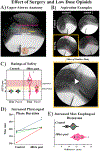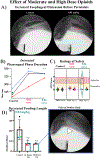Dysphagia as a Missing Link Between Post-surgical- and Opioid-Related Pneumonia
- PMID: 38538927
- PMCID: PMC11135177
- DOI: 10.1007/s00408-024-00672-8
Dysphagia as a Missing Link Between Post-surgical- and Opioid-Related Pneumonia
Abstract
Purpose: Postoperative pneumonia remains a common complication of surgery, despite increased attention. The purpose of our study was to determine the effects of routine surgery and post-surgical opioid administration on airway protection risk.
Methods: Eight healthy adult cats were evaluated to determine changes in airway protection status and for evidence of dysphagia in two experiments. (1) In four female cats, airway protection status was tracked following routine abdominal surgery (spay surgery) plus low-dose opioid administration (buprenorphine 0.015 mg/kg, IM, q8-12 h; n = 5). (2) Using a cross-over design, four naive cats (2 male, 2 female) were treated with moderate-dose (0.02 mg/kg) or high-dose (0.04 mg/kg) buprenorphine (IM, q8-12 h; n = 5).
Results: Airway protection was significantly affected in both experiments, but the most severe deficits occurred post-surgically as 75% of the animals exhibited silent aspiration.
Conclusion: Oropharyngeal swallow is impaired by the partial mu-opioid receptor agonist buprenorphine, most remarkably in the postoperative setting. These findings have implications for the prevention and management of aspiration pneumonia in vulnerable populations.
Keywords: Aspiration; Dysphagia; Opioid; Pneumonia; Postoperative; Swallow.
© 2024. The Author(s), under exclusive licence to Springer Science+Business Media, LLC, part of Springer Nature.
Conflict of interest statement
Figures


References
-
- Haller L, et al., Post-Operative Dysphagia in Anterior Cervical Discectomy and Fusion. Ann Otol Rhinol Laryngol, 2022. 131(3): p. 289–294. - PubMed
-
- Goeze A, et al., [Post-operative prevalence of dysphagia in head-and-neck cancer patients in the acute care units]. Laryngorhinootologie, 2022. 101(4): p. 320–326. - PubMed
-
- Greenberg JA, et al., Evaluation of post-operative dysphagia following anti-reflux surgery. Surg Endosc, 2022. 36(7): p. 5456–5466. - PubMed
Publication types
MeSH terms
Substances
Grants and funding
LinkOut - more resources
Full Text Sources
Medical
Research Materials
Miscellaneous

